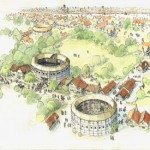 Elizabethan audiences at The Globe and The Rose theaters gnoshed on oysters, mussels, hazelnuts, walnuts, pies and dried fruit while attending plays by the likes of Shakepeare and Marlowe.
Elizabethan audiences at The Globe and The Rose theaters gnoshed on oysters, mussels, hazelnuts, walnuts, pies and dried fruit while attending plays by the likes of Shakepeare and Marlowe.
The evidence has emerged from the most detailed study ever carried out on a Tudor or early Stuart playhouse. Archaeologists have been analysing the thousands of seeds, pips, stones, nutshell fragments, shellfish remains and fish and animal bones found on the site of the Rose Playhouse on London’s South Bank.
Museum of London Archaeology has just published the findings in The Rose and The Globe: Playhouses of Shakespeare’s Bankside, written by archaeologists Julian Bowsher and Pat Miller.
Bowsher and Miller found that there was an identifiable class component to what audiences ate. The standing crowd in the open area in front of the stage — felicitously referred to as “groundlings” or “stinkards” — mainly stuck with shellfish and nuts. In fact, the huge quantities of discarded hazelnut shells doubled as a kind of sawdust layer on the floor to absorb the many grossnesses of weather and population density.
Oysters remained a staple in the diet of London’s poor well into the Victorian period, Bowsher notes. Large quantities of oyster shells have been found in pretty much every excavation she’s done at the Museum of London Archaeology.
The covered gallery seats where the monied theater-goers gatheredl, on the other hand, show evidence of a more rarefied diet of crab, sturgeon and imported dried fruit like raisins, fig and peaches.
There are also remnants of New World contributions to Elizabethan culture, like pumpkin seeds and tobacco leavings. Sir Walter Raleigh had only introduced Virginia tobacco to England in 1578, but audiences at The Globe and The Rose seem to have been smoking pipes just 10 years later.
We know tobacco was being grown on the banks of Thames already, but we don’t actually know that it was Virginia tobacco, though. It could have been Latin American tobacco via Spain’s colonies which was introduced to Europeans right after Columbus sailed the ocean blue.
